Echo Swinford, the one-woman team behind presentation consultancy Echosvoice, has been a PowerPoint MVP since 2000. She’s President of the Presentation Guild, an author, and a templates master! Once we got that bad pun out of the way, we were fortunate enough to sit down with Echo and talk all things presentations. Read on to learn how Echo got started in the world of presentations, helped build the presentation community we know and love, and discuss what she thinks is next for the industry.
Hi Echo! You started out in a medical education environment and just a few years later you were a Microsoft PowerPoint MVP – what did that journey look like?
I had just come back from my first job after college – teaching English in Japan – and it was the middle of a recession and there weren’t many jobs. So, I was doing temp work at a MedEd company. I was just doing office work, but we had some symposia coming up and the owner of the company was thinking about outsourcing her slide work, but she was concerned about quality control. I convinced her to let me create the slides. What had I gotten myself into?! I had no idea how to use PowerPoint! I had to go and learn, and I had to learn really fast.
PowerPoint is intuitive and we always say that is its downfall – the good thing and the bad thing about PowerPoint – but I was able to do what I needed to do. It didn’t take very long at all for me to hit a wall, though. So, I started reading an NNTP news group for PowerPoint. I read it religiously. I started asking questions, and eventually I started answering questions, and then Microsoft came along and made me an MVP. That’s the long and short of it – pretty cool!
That passion for teaching yourself and learning to teach others really shows in other projects you have launched over the years.
I think you’re right. You might understand something intrinsically, but when you have to teach it to someone else you have to have a level of understanding that is a lot deeper than what you need to execute something. I get a kick out of that. It motivates me. There are PowerPoint features that I would never ever use but I have to dig into them sometimes to help other people understand them.
I’m glad to have the resource of the other MVPs now to ask questions and, you know, we started to build a community around everything because of that.
The idea of community takes us nicely to the Presentation Guild. What was it that motivated you to set up the Presentation Guild? You already had connections with people in the industry so what was important about formalising it?
The MVPs talked about starting an association for years. At one point, in the early 2000s, we were talking in the NNTP news group and Kathy Jacobs said we should have a party after Thanksgiving and offered to host it at her house. We were all laughing but people said, ‘I’d be there, I’ll come’. After about 30 or 40 people said this we thought, “There might be something here!” So, we talked to Rick Altman and he started The Presentation Summit conference. But we always talked about how we would like to extend that for a longer period – something year-round instead. It was important for us to connect with our colleagues more than just once a year because in our industry there are a lot of self-employed people and people working in small creative services departments.
Fast forward a few years: I got a new computer and I had to re-install all my Adobe programs. When I had to set up my account one of the things that they asked was, “What do you do for a living?” And there was every kind of design there that you can imagine – textile design and billboard design and magazine layout – all this stuff but nothing about presentations. I thought, you know what, I’m so over this: our profession should be on the list! It felt like the time to set this up, time to start moving this industry forward and getting some recognition. So that’s what we did.
So, the Presentation Guild was created to really raise the profile of the presentation industry?
Yes, on the recognition front, one of things we wanted to do was advocate for and raise the profile of our presentation profession. At the moment, you tell people, “I design presentations for a living,” and they are like “What is that?” We need to start talking to the business community and the education community about how to elevate that. More people need to give more recognition to the presentation profession because, you know, this is a profession.
Alongside raising the profile of the presentation industry in general, how does the Guild practically help its members tackle challenges they face as individuals?
Well, it is a very new organisation, I think we are officially three years old now. And what we have tried to do is create a community that supports people with presentation questions; questions about how to tackle things on a business level, questions about software, whether it is Prezi, PowerPoint or Keynote. We consider ourselves software agnostic: we like to support all those programs.
We are getting ready to start expanding our own training library so our members can learn what they need to learn in order to be able to take our certification exam. That’s our next big launch. It’s the next step in that advocacy – a rising tide lifts all boats kind of thing.
We want to help people prove that they have skills. Of course it’s important for us to keep raising the profile more broadly, but at an individual level, when our members can go to HR and say, “I am a certified presentation expert,” that helps them make more money. That is one of the biggest benefits for our members. Currently, there is no infrastructure to help you do that, there is nothing out there. So that is what we want to help people do, validate their skills and validate what they do.
So, the certification is all about validating skills and enabling members to prove presentation expertise. I’m sure there are a million things that could have gone into it! What was the process involved in developing the certification?
I tech edited a PowerPoint exam at one point and a lot of questions were structured in this way: How do you insert a picture? a) You click Pictures on the Insert tab b) You click Pictures on the View tab… etc.
That’s not the kind of thing we want people to know, we don’t care where a button is! We want you know how to insert a picture and then crop it or manipulate it in the way you need to. That’s the goal.
We developed a set of standards a couple of years ago. We got together whole a community of presentation people and MVPs. I wish I had known Richard at that time and people from BrightCarbon! We looked at it from the perspective of if you were going to hire somebody as an entry level PowerPoint specialist and they needed to be able to clean up decks and pull them together, what would you expect them to be able to do? And then what would you expect for a senior presentation person? And then what about at the very, highest expert superhero level – what does that look like? We spent a lot of time trying to figure that out what that person really needs to know at these different levels. It took us a long time and is always a work in progress. We’re starting out with the Certified PowerPoint Specialist exam and then we’ll add Expert and Master levels and then certifications for Prezi and Keynote and potentially other software also.
The standards fall into 9 categories and we developed the certification tests around the categories. If you’re planning to take the certification, download the standards – available on our website under Certifications – and study them. They will tell you what you need to know, what areas you need to study and what differentiates the levels of certification.
The certification itself has two parts: a timed multiple-choice test with questions from all 9 categories, and a practical exam with a file for each category and tasks to complete. For example, one of the modules is about audio-video and the tasks might be: Insert the video and do this with it or do that with it. The multiple-choice test takes a couple hours and for the practical exam you have a couple of days to complete the tasks and send them back.
The final thing is the experience component. For the PowerPoint Specialist credential, you have to be able to document that you have six months’ worth of experience working in PowerPoint, or 1000 hours. If you’re already employed as a presentation specialist, then that shouldn’t be difficult to do.
Wow, that sounds really robust! And all of that is to make sure that when people go and take this to their HR departments and say ‘I am certified’ it really means something and has weight?
Exactly. We do want it to have weight, mean something and be helpful and useful to people who get certified.
We look forward to the launch! Though you say yourself that the Guild hasn’t been going for too long, it’s clearly been a busy few years. Have you already stared to see tangible changes from the Guild’s influence?
You know, I’ve always said that the worst templates in the world are the ones that cross my desk, because people contact me when they are desperate for help – I don’t get the easy ones! But I have actually started to see templates recently that are really well done, and it makes me feel really good. People are starting to see the value in having well-crafted and well-constructed presentations.
We’re starting to see more on social media about presentations and people are more cognisant of not just throwing everything on a slide. People are recognising the value of having beautiful well-designed presentations like you do – those really high-end, lovely, beautiful, amazing, wonderfully designed presentations (we promise we didn’t pay Echo to say this!).
It is so great that people are starting to value good presentation design. Something we’ve seen is that when people see a bad presentation, they often point to PowerPoint as the culprit. As a PowerPoint MVP, what do you say to people when they blame boring presentations on the tools?
You know there was a whole Twitter thread recently that started when someone compared a graphic designer being asked to do a PowerPoint presentation to a chef being asked to microwave some Hot Pockets. It made us all laugh and roll our eyes, but I think all we can do is push back on that attitude and talk about the importance of structuring a presentation right and then putting the visuals to it. Mostly it boils down to getting away from the idea that the visuals come first. Whatever you do in the tool is only as good as what you have structured before. I’m sure you experience that right? You guys help your clients structure their presentations, so they make sense and you get all their words off the slide?
Yes, that’s what we spend a lot of our time doing! Sometimes our clients say, “I don’t want it to look like a PowerPoint” but we know that’s it’s not PowerPoint that is the real issue.
Exactly. When my clients say they want something that doesn’t look like PowerPoint I start by saying, if you want something that works better visually then you have to get the words off the slide. They can be your speaker notes but your brain dump needs to go elsewhere: the words are just there to support you. Then we talk a little bit about cognitive science to explain to clients how people can only take in so much information, and if an audience is listening to you both talk and read what is on the slide, they don’t absorb either one. That can help people understand, but sometimes people are just resistant.
Often people think a new piece of technology or a new app is going to help us all make amazing presentations straight away. But, like you, we see our role as to guiding people towards the theory behind presentations, the science and the skills needed to create effective slides. That’s what’s going to make a difference. Is that a part of what the Presentation Guild is doing, too?
Yes, and I would love to be able to put that message out on a broader scale. That’s what we are always working towards. It’s going to take us a while to get there but that’s exactly right because there is so much more to presentation creation than just the visual portion.
We have a lot of speech coaches and presentation coaches who are members of the Guild and we’re trying to figure out how to help the people who do just the visuals understand more about the storytelling portion of it, and we want to help the speech coaches understand more about the visuals and some of the technology, so they can both leverage each other. They are different skillsets, but we are all working in the same space. And sometimes it takes a whole team to create something that really supports a speaker.
Do you think that there will be a shift from a lone PowerPoint expert in an organisation to people working more holistically with others, bringing in different perspectives?
That’s a perfect way to put it and yes, I think we are seeing more and more of that as we move forward. And remember, this is such a baby industry! I think sometimes, in businesses, we get slated into this slide jockey job where we are just knocking out slides and making them look good but there is a next level.
Now, presentation experts are helping more holistically—advising on what is going to work better, finding better ways to display information, or to explain processes. People are starting to see their PowerPoint person as more of a storytelling specialist as well. That is the way this industry is moving. We are seeing more and more agencies like yours also. There are still a lot of independents but there are so many more presentation-specific agencies coming out. I think that we are just on the cusp of this huge industry that is going to explode.
What do you think is pushing us towards this explosion?
We see more of an emphasis everywhere on telling stories. There is so much competing for our attention and people are starting to see the value in being able to connect with their CEO with a very high-level presentation, for example, and understanding who they are talking to and what is going to help the audience respond. I think that it is a worldwide push and our industry is seeing some of the benefits.
And, what are the things we should collectively be aiming towards as an industry as we grow?
People need to understand, and I think that we as presentationists need to understand, that it isn’t just about the visuals; it is about the content, about helping someone get the point across. We see that, but we need to learn the skills to help our clients, so I think that that is where our industry is going to grow. There is this balance between visual skills, design skills, business skills, content skills: all of this is important! I think that a lot of agencies probably want to hire designers and teach them how to do PowerPoint. A lot of us coming in from PowerPoint are not trained designers, myself included, and there is room for us in the graphic design industry to help widen that and broaden that focus on a presentation. There are so many different, additional skills needed other than just graphic design and solving visual problems. So I think that is where there is room for growth.
It’s exciting to look towards the future for the presentation industry. Thinking about the future of PowerPoint specifically, there are so many new features coming in via the 365 model. What are your favourite features and what is on your wish list?
My wish list is huge! I want them to improve tables. That’s the silliest thing but it’s at the top of mind because one of my clients and I were dealing with a nasty table this week.
I think that morph is amazing and can really help support content because it makes it so much faster for us to do certain kinds of animations; to move from one object to another or one slide to another and to pull things together. I think that the possibilities there are just amazing. I love that they did that because, seriously, doing all that stuff with motion paths in the past – it could just eat up days!
The AI stuff that they’re putting into PowerPoint is kind of amazing. They just announced this presentation coach feature which will help you see if you’re speaking too quickly and tell you to slow down or if you are saying ‘um’ every third word it will flag that for you. It can help people become better presenters.
I also really like the fact that Designer is now not just working with Microsoft themes but will work with custom corporate themes. My corporate clients have been asking for that since Designer came out. This just rolled out a couple of days ago and I’m really excited to see it. With AI we have no idea how far it is going to go.
With 3D, right now we see auto companies, shoe companies have these amazing 3D models. The fact you can put a model on the slide and have a 360° view can make for a great presentation! I think we are going to see more and more industries and products start building into that 3D capability in the future.
I love that Microsoft starts thinking now about what will happen in the future and starts laying the groundwork for it.
With these 3D models we are seeing another area of design pulling into presentation design again. It really shows the versatility of PowerPoint!
People use PowerPoint to make explainer videos and things like that because PowerPoint is this all-purpose authoring tool. People use it for newsletters because you can get a nice PDF out of it: it’s a good page layout program. It is not as robust with text like Word, and it’s not easy to get one column to go into another the way InDesign does, but it is everyman’s page layout programme. So PowerPoint gets used for all kinds of crazy things and I think we are going to see more and more of that unless the layman’s version of InDesign comes out: I don’t see that happening any time soon.
Before we wrap up, we’ve been talking about all these possibilities and future developments. Where do you look for inspiration, to see what is next and to find ways to keep presentations fresh and modern?
Honestly, I rely on Julie Terberg – she is my go-to! But a lot of times I take pictures of things I see on my TV or magazines or billboards. I know that sounds crazy but a lot of times adverts or interstitials will flash across the screen and I rewind and pause and take little snapshots. One of the tricks I learnt from Julie is to keep that kind of stuff all in one place so you can go through it later. I also take lots and lots of screen grabs of quotations because I always end up doing quotation slides and I get tired of them all looking the same. Or sometimes it’s just snaps of colour sets that I like.
I think one of the pushes that we are seeing is in data visualisation, so I tend to look at a lot of data viz sites like Nate Silver’s fivethirtyeight.com. Nate’s stuff is always impactful, whether it is about politics or sports. And there are a lot of news sites that are doing really amazing work in this area; The New York Times, The Washington Post, and The Guardian have really good infographics and data vis. And they are interactive! That’s what is so cool! I cannot even imagine the coding and the stuff that has to go on in the background, the people who do that are amazing. I can make a good-looking chart and I can make that data understandable but to do that kind of interactivity – I just admire that so much.
Thanks so much to Echo for chatting to us! If you want to keep up to date with what Echo Swinford is up to, follow her on Twitter. And to learn more about the thinking behind both Echo’s and BrightCarbon’s approach to presentation design, check out our blog post on creating visual presentations.
Leave a comment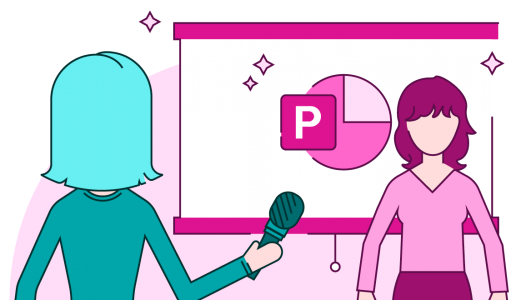

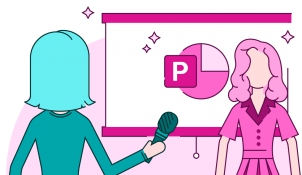
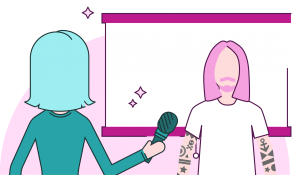
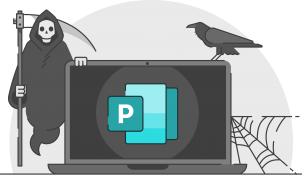
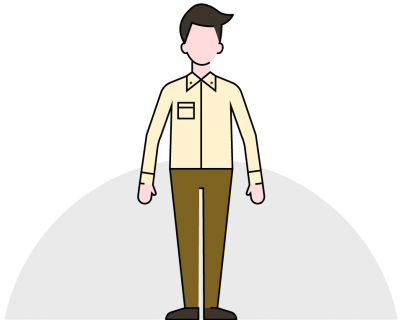
Awesome interview!
Thank you, BrightCarbon, for featuring this industry giant. And thank you, Echo for your committment to legitimizing the presentation industry.